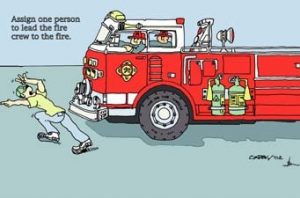Ever see this? A fire crew, performing routine inspections, parks its big, red, American LaFrance truck in front of the sign shop. The shop secretary, well trained for this action, spots the truck, jumps up and scurries to the shop door, shouting, “Quick! The fire department inspectors are here!” The shop instantly becomes a mad beehive. In the blurred action of an old-time movie, the welders douse their torches and check their riggings, wires and grounds, then rush to get rid of slag remnants, especially those near rags or flammable objects. In the neon room, benders check secondary high-voltage cables, mercury traps, hydrofluoric-acid vials and, in back, the paint guys are cramming NFPA diamond-label solvent and paint cans into fireproof lockers while shoving smelly rags into metal containers. They even turn the radio volume down. Moments later, blue-suited firemen walk into the shop and find a congregation of hallowed saints quietly making signs and a place compliant with every safety law known to man and OSHA. It’s fun to watch. But, in truth, fire and fire hazards aren’t funny. Daily we read media reports on the terrible Hayman forest fire in Colorado and the Rodeo-Chediski fire in Arizona’s beautiful Mogollon Rim country (the setting for Zane Grey’s western novels). Both, to date, have destroyed more than 700 structures, burned more than 200,000 acres and displaced thousands of people. The economic loss — homes, jobs, tourism, industry — is unfathomable and, hopefully, by the time you read this, these fires will be extinguished. In homes and businesses, the best way to prevent a fire is to be ready for a fire. To be ready means you not only have emergency equipment, but that you’ve planned, trained your staff and practiced for the emergency. Let me tell you a sad story about a four-year old boy who died in a flaming boat. The accident occurred at a lake marina near Bath, NC. The boat was barely 15 ft. from the dock. A fuel explosion caused the fire. By one means or another, it sent the others out of the boat, but the boy, Jeremia, remained. Because of the fire’s intensity, rescuers couldn’t reach him. They repeatedly shouted for him to jump. But Jeremia hadn’t been taught a most basic boating safety exercise: to jump into the water. Afraid of the flames and afraid of the water, he remained, and died, on the boat. Do you — and all of your co-workers — know emergency procedures? Have you practiced them? Or, do you believe it will never happen or, if it does happen, that you’ll be there to handle things? Take five and review some basic procedures with me. Then get the shop people together and teach them what to do. Act fast when you see a fire. Most fires start out small, but grow out of control in an amazingly short period of time. If you have the proper fire extinguisher, and if the fire is small, put it out. Shout, yell, sound the alarm! Don’t trust your abilities, and don’t underestimate the fire. Warn everyone within the area, and tell them to warn others to move to a safe place. Assign one person to call 911. Don’t say “Someone call 911.” Instead, point to a reliable person, call him or her by name and tell him to call 911 immediately. Assign one or more persons to meet and direct the firefighters. Firefighters know their neighborhoods and, through their annual inspections, they also know your shop. They don’t know the exact location of the fire. Again, call the employee by name, assign him or her to go outside and lead the fire crew directly to the fire. If the fires gets out of control, get away. Absolute rule: Life is more important than property. Clear the building and don’t let anyone go back in. Have one place where everyone meets to ensure that everyone is safely outside. This also gives you a central location for finding and briefing your staff, plus assigning necessary tasks. Help only if you’re asked. Let the professional firefighters do the job, but tell the fire chief who you are, where you are and that you and your staff are ready to help. If someone is injured, get trained medical help immediately. And, just as with the firefighters, assign one person to go outside to lead the medical team to the injured person. Also, be sure any injured person is moved away from danger, but be equally sure you don’t harm them further in the process. It’s a good idea to have you and your shop leaders trained in first aid. Call your lawyer. Believe me, the fire itself is the proverbial tip of the iceberg. Plan for the next day. Look at what this country — and especially the New York City businesses — did after the World Trade Center attack. Whether the damage is severe or minor, get your staff organized so that your business continues the next day.


 Tip Sheet1 week ago
Tip Sheet1 week ago
 Photo Gallery2 days ago
Photo Gallery2 days ago
 Ask Signs of the Times4 days ago
Ask Signs of the Times4 days ago
 Real Deal1 week ago
Real Deal1 week ago
 Benchmarks6 days ago
Benchmarks6 days ago
 Women in Signs1 week ago
Women in Signs1 week ago
 Photo Gallery1 week ago
Photo Gallery1 week ago
 Women in Signs1 week ago
Women in Signs1 week ago

















